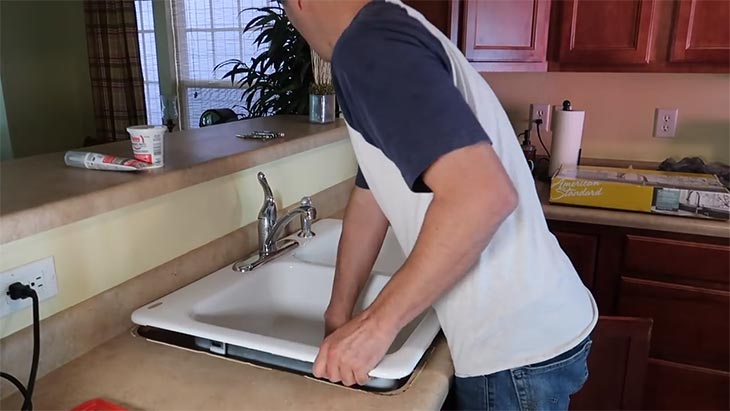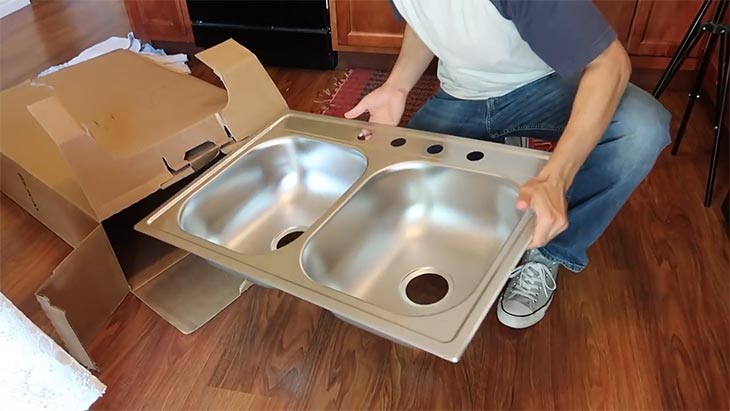Table of Contents
Installation of a kitchen sink can be a simple task, but you must carefully follow all instructions. Even a simple mistake can make this task a nightmare. For this reason, arrange all tools and accessories before installation. Moreover, it is essential to understand the complete procedure to Install a Kitchen Sink.
The tricky part of the installation is connections between the drain of the sink and faucet. Here are some easy steps for the installation of a new kitchen sink.
How to Remove a Kitchen Sink – 6 Steps to Remove Kitchen Sink
Buy a New Sink
Measure your current sink if you want to replace it. Sometimes, you have to modify plumbing and countertop opening. Feel free to draw an old sink with its measurements. These will include the distance from the sink wall to the center of the drain. This drawing will make shopping easy.
Remove an Old Sink
Before installing a new sink, you have to remove an old one. It will be great to take a picture of plumbing configurations. This picture will become a handy reference to reassemble the plumbing after installation.

Turn off all the water supply lines along with valves in the cabinet under your sink. If you are unable to find these lines, make sure to turn off your main water line. Relive pressure of water in lines by turning on two or more faucets.
To disconnect supply lines, you will need adjustable wrenches. Collect remaining water in a small bucket. For a garbage disposer, shut down the circuit and unplug it. You must have pliers to disconnect P-trap and drainpipe from sink drains. Remove the drain line of the dishwasher and disposer.
Locate metal clips under your counter and make them loose using a screwdriver. You can use a utility knife to cut the seal around your sink. Lift away the old sink by pushing this unit. Putty knives are useful to remove caulk, grim, and putty of an old plumber from the countertop.
Buy and Install a Kitchen Sink
After removing all the debris, you are ready to install a new kitchen sink. Set your new sink in the designated hot to measure its fittings. Feel free to use a router, tile cutter, or jigsaw to modify the opening of the countertop.
For a larger sink, you have to trace an outline for creating a new cutout. Put the sink on the hole of the countertop upside-down and trace to cut with your jigsaw.
Remove the sink from the hole and attach clips. You have to turn them inward toward the bowl of the sink. It is vital to install extra components and faucets. Apply some plumber putty around the strainer of the drain to install the strainer. Press the drainer firmly against your putty.

To put and secure gaskets of rubber, tilt your sink. Moreover, you have to thread flange to the underside of a sink drain. Replicate this process for extra drains without any disposer. A soft towel is suitable to remove extra putty.
Install a mounting bracket to the base of the sink to install a garbage disposer, if any. Make sure to follow the instructions of the manufacturer. Apply small beads of silicone sealant toward the edge of your basin.
Carefully lower your sink down in the opening of the countertop and align squarely. Rotate attachment clips of metal outward under the sink and make the screws or nuts tight.
Now, attach supply lines to different water connections of faucet and pipes. Make connections tight and avoid overtightening or stripping the threads.
Garbage Disposer
For a garbage disposer, you have to follow the instructions of the manufacturer. Carefully insert a discharge pipe and make all the clamps tight. Reinstall the drain of the dishwasher and connect the disposer discharge pipe to the drainpipe of the sink. Reattach a P-trap to complete this installation.
Before installing old drainpipes, you have to ensure if these pipes need some adjustments. You can cut a long pipe to get the desired length. Measure the required length and add some extra inches while measuring the length for a secure connection.
The hacksaw will help you to cut the pipe. It is essential to wear safety glasses before you start working. Put a washer on a pipe and slide one slip nut on the washer of pipe. Sometimes, you will need one slip nut for another end of the pipe.
Slide this nut on the pipe from an appropriate direction. Finally, add one washer. Hold this pipe at the right place and screw a slip nut. If your pipe is small, feel free to buy a new pipe. Flexible extension pipes are available in the market to make your work easy.
Apply some sealant to the sink perimeter. Reconnect the disposer power and turn on the water to check possible leaks.
Final Verdict
If you are going to install a kitchen sink for the first time, this guide will help you. Carefully follow all the instructions to replace an old sink. Feel free to hire a professional for this job if you have several other elements attached to your sink. For instance, dishwasher installation can be complicated.

